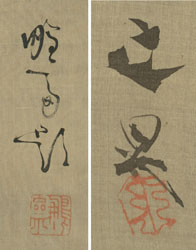Nanga
Plum branchSigned: Bunchô, Bôsai dai
Seals: unread, Bôsai
Technique: sumi on dark washed silk 102 x 33
Mounting: blue brocade and beige silk 182 xz 44.8
Condition: good
Bunchō was the eldest son of Tani Rokkoku (1729-1809), a retainer of the Tayasu daimyō family and a well-known poet. From the age of ten Bunchō took painting lessons with the Kanô painter Katô Bunrei (1706-82). After about ten years of Kanô training, around the year of Bunrei’s death he started to experiment in a wide range of other styles. He was taught the decorative Chinese painting style of Shen Nan P’in by Watanabe Gentai. The Yuan and Ming styles as well as the European styles he learned from Kitayama Kangan (1767-1801), the Sesshû style from Sakurai Sekkan (1715-90) (Sesshû XII) and Maruyama-Shijô painting from Watanabe Nangaku (1767-1813). From Go Shun, whom he met a couple of times travelling the Kansai region, he picked up the Buson style.
In 1792 Bunchō was appointed personal attendant to Matsudaira Sadanobu (1758-1829), the head of the shogunate’s Council of Elders, and accompanied him on his travels from 1787 to 1793. In 1794 Bunchô organized probably the first exhibition of contemporary painting in Edo, just like Minegawa Kien (1734-1807) had organized his Shin Shoga Tenkan* in Kyoto. In 1812 Sadanobu retired. After his employer’s death in 1829 Bunchō took the tonsure and was appointed on’eshi (distinguished painting master) by the Matsudaira family and he was generously awarded a yearly stipend of 150 koku. in 1837 he received the honorary rank of hôgen.
Bunchô was a wealthy man who was hardly able to satisfy the demand for his paintings.
Reference:
Tochigi 1979
Rosenfield B.91
Berry & Morioka ’08 p. 301-02
Roberts p. 10
Araki p. 204 ff.
Bôsai was one of the important literati figures in Edo. His painting, which he pursued as a hobby, was much influenced by Yüan art. He was better known as a Confucian scholar and a writer than as an artist.
Bôsai studied under Inoue Kinga. He established his own school and became very famous. Later in life he ceased studying and teaching and spent the rest of his days composing poetry and drinking sake.
Reference:
Addiss 1984
Setagaya 1998
Roberts p. 9
Araki pp. 2698-2699
Rosenfield B.34 (# 147)
Price: ON REQUEST

